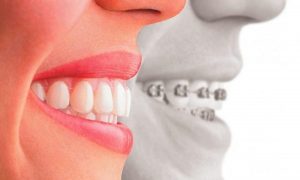 What is Invisalign?
What is Invisalign?
Invisalign is a type of clear aligner for straightening or realigning your teeth. These clear aligners are made from flexible thermoplastic material.
Invisalign is the oldest and best known clear aligner and was introduced in 1998 by Align Technology. The original Invisalign® was developed with adults in mind and designed to make orthodontic treatment ‘less conspicuous’ according to the American Association of Orthodontics. This ‘invisibility’ provides a more attractive appearance during treatment that is preferred by working professionals and others.
Invisalign is an available treatment for certain types of bite issues, and crowding and spacing issues with your teeth. It is generally more suitable for milder cases that do not require extraction of teeth. In such cases Invisalign may be a faster treatment compared to braces.
Some research has shown Invisalign is successful in managing overbites, deep bites and open bites, as well as other misalignments. However, there is currently insufficient clinical research to fully support those claims of effectiveness. From the dental patients’ perspective, Invisalign aligners are shown to be more comfortable to wear compared to braces.
Potential Benefits:
- Invisalign provides a more attractive appearance during treatment, due to its ‘invisibility’.
- Healthier gums and teeth due to easier access for thorough brushing and flossing
- Convenient removability for cleaning, eating and special occasions
- Reduced likelihood of irritation to soft oral tissues, so no mouth sores.
- More comfortable to wear.
- Shorter treatment times compared to braces for routine cases.
Potential Downsides:
- Not suitable for all cases or requires supplemental braces.
- More expensive option to braces.
- Must remember to remove aligners for eating and drinking (except for water).
- Must remember to wear your aligners for 20-22 hours each day.
- Aligners are more susceptible to staining, damage and breakage.
Should you consider Invisalign? 
If you’re interested in Invisalign for orthodontic treatment, some helpful questions to consider in consultation with our dentists are:
- Is my bite and teeth spacing or crowding issues straightforward?
- Am I self-conscious about the appearance of wearing braces, so need something ‘invisible’?
- Am I able to strictly comply with the hours of wear?
- Will I remember to remove them for eating and drinking?
- Am I disciplined enough to clean and care for my teeth aligners daily?
- Am I responsible and not likely to lose my Invisalign aligners?
For younger patients there is Invisalign Teen®, though generally braces are recommended for younger patients to eliminate issues that can arise with compliance and care of Invisalign.
Considering orthodontic treatment is a big decision that needs the input from your dentist. Our highly experienced caring dentists at East Ringwood dental clinic are here to assist you. Please call us on (03) 9870 8243 to make a dental appointment or contact the dental clinic here.
REFERENCES
Haouili, N., Kravitz, N. D., Vaid, N. R., Ferguson, D. J., & Makki, L. (2020). Has Invisalign improved? A prospective follow-up study on the efficacy of tooth movement with Invisalign. American Journal of Orthodontics and Dentofacial Orthopedics, 158(3), 420–425. https://doi.org/10.1016/j.ajodo.2019.12.015
Khosravi, R., Cohanim, B., Hujoel, P., Daher, S., Neal, M., Liu, W., & Huang, G. (2017). Management of overbite with the Invisalign appliance. American Journal of Orthodontics and Dentofacial Orthopedics, 151(4), 691-699.e2. https://doi.org/10.1016/j.ajodo.2016.09.022
Papadimitriou, A., Mousoulea, S., Gkantidis, N., & Kloukos, D. (2018). Clinical effectiveness of Invisalign® orthodontic treatment: a systematic review. Progress in Orthodontics, 19(37). https://doi.org/10.1186/s40510-018-0235-z
Rossini, G., Parrini, S., Castroflorio, T., Deregibus, A., & Debernardi, C. L. (2015). Efficacy of clear aligners in controlling orthodontic tooth movement: A systematic review. The Angle Orthodontist, 85(5), 881–889. https://doi.org/10.2319/061614-436.1
Weir, T. (2017). Clear aligners in orthodontic treatment. Australian Dental Journal, 62(1), 58–62. https://doi.org/10.1111/adj.12480

